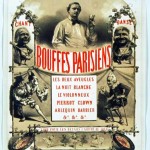Commedia dell’arte and opera are the dual threads that eventually spun into what we call musical theater. Let’s take a closer look at that second thread and its journey toward early musical theater. As I wrote yesterday, in the 18th century, Italian opera gave rise to opera buffa, a variation that included spoken dialogue and lighter music. Vienna saw the first budding of the form, but Paris saw the full bloom of what we now call operetta. Hervé’s Don Quichotte and Sancho Panza is considered the first genuine operetta, but the man responsible for the form’s international popularity is Jacques Offenbach.
Though he was a successful cellist and conductor, Offenbach wanted to compose. Unable to find many producers interested in his work, he leased Salle Lacaze, a 300-seat theater off the Champs Élysées in Paris, to present his own short comic operas. The newly christened Théâtre des Bouffes-Parisiens opened on July 5, 1855, with Offenbach’s one-act Two Blind Men on the bill. It was a smash and soon had productions from Vienna to London. Four years later, Offenbach premiered his first full-length, Orpheus the Underworld, which was another hit. In all, Offenbach self-produced more than 50 works, about half of them one-act and half of them full-length.
While conducting in Vienna, Offenbach met Johann Strauss II and suggested that he branch out from writing waltzes and try his hand at comic opera. Strauss did. After two abandoned projects, Strauss had his first production at Theater an der Wien in 1871: Indigo and the Forty Thieves. “It consists of dance music on which Strauss has overlaid text and characters,” one critic wrote, but “is a foretaste of great things to come.” And it was. In 1874, Strauss premiered Die Fledermaus, heralding the golden age of operetta in Vienna.
Offenbach’s influence continued to expand — from Paris to Vienna and, most important in the history of musical theater, to London. In 1869, Offenbach sent his comic opera The Brigands to dramatist W.S. Gilbert, asking if he would be interested in adapting it for the English stage. Gilbert’s translation was published in 1871 but not performed until 1889 in New York City.
Meanwhile, producer Richard D’Oyly Carte needed a short after-piece for an 1875 production of Offenbach’s La Périchole at the Royalty Theatre. He asked Gilbert, who offered the idea of “Trial by Jury: An Operetta” (read here), his 1868 comic skit for the magazine Fun. Gilbert and Arthur Sullivan had worked on John Hollingshead’s successful 1871 Christmas production of Thespis, which parodied Offenbach’s Orpheus in the Underworld, so Carte asked Sullivan to write the music.
Trial by Jury was a hit, outlasting the run of La Périchole, so Carte commissioned Gilbert and Sullivan to write a comic opera for his newly formed Comedy Opera Company. Carte had tired of producing badly translated French operettas and saw a chance to develop an English form of light opera. Over the next 25 years, Gilbert and Sullivan wrote 14 wildly successful comic operas for Carte, including The Pirates of Penzance in 1879, which bears a striking resemblance to The Brigands.
The Paris-style comic operettas and Vienna-style romantic operettas were both popular with U.S. audiences and with American composers. Reginald de Koven leaned toward the French comic style (as in Robin Hood), while Victor Herbert leaned toward the “Ruritanian” romantic style (as in Naughty Marietta). The European composers who found success in the U.S. primarily favored romances, including Hungarian Franz Lehár (The Merry Widow), Hungarian Sigmund Romberg (The Desert Song), and Czech Rudolf Friml (Rose-Marie).
Several of Romberg and Friml’s most popular works were adapted for the New York stage by Otto Harbach and Oscar Hammerstein II, who both later worked with Jerome Kern to begin crafting a true American musical theater.
To sample the European roots of musical theater, listen to the songs “Modern Major General” (watch here) from Pirates of Penzance (1879), “Vilja” (watch here) from The Merry Widow (1905), “Ah! Sweet Mystery of Life” (watch here) from Naughty Marietta (1910), “Indian Love Call” (watch here) from Rose-Marie (1924), and “Stouthearted Men” (watch here) from The Desert Song (1926).

